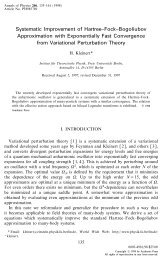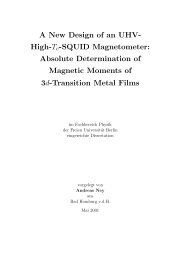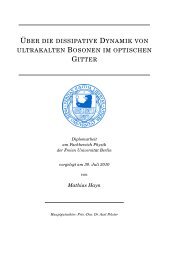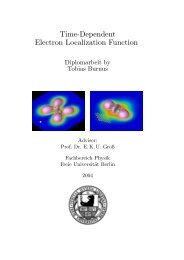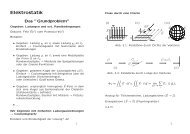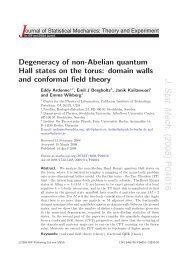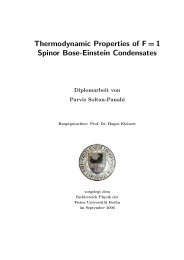Diploma thesis
Diploma thesis
Diploma thesis
You also want an ePaper? Increase the reach of your titles
YUMPU automatically turns print PDFs into web optimized ePapers that Google loves.
Abstract<br />
Since 1924 theoretically predicted, the first realization of a Bose-Einstein-Condensate (BEC) in<br />
1995 was the begin of many experiments and investigations of such systems. Some of them consider<br />
dissipative effects of a BEC, which are caused for example by the interaction of a condensate<br />
with an electron beam. This diploma <strong>thesis</strong> considers a theoretical model which should make<br />
predictions about the dynamics and the general behaviour of a harmonic trapped BEC that interacts<br />
with such an electron beam. This beam is supposed to be Gaussian and we model it via an<br />
imaginary potential, while the harmonic trap is described via a real potential. This ansatz leads<br />
under the assumption of a noninteracting Bose gas to a non-Hermitian Hamilton operator, whose<br />
influence is concisely discussed in a short section about non-Hermitian dynamics. For example we<br />
have to deal with complex energy eigenvalues, which are consequently caused by non-stationary<br />
eigenstates. Thus the non-vanishing imaginary part of the energies leads to a damped or increased<br />
density.<br />
In order to calculate these eigenvalues and eigenstates, we first consider a crudely simplified system,<br />
that is we just take a one-dimensional potential, neglect any interaction of the bosons contained<br />
in the BEC and approximate the whole complex potential by two nested square well potentials.<br />
For this system we solve the Schrödinger equation for several dissipation strengths as well as beam<br />
waists and evaluate expressions for the wave functions and equations for the energies that we solve<br />
numerically afterwards. The calculated energies always yield a non-positive imaginary part, so<br />
the complex potential well indeed exhibits a damping effect. Furthermore, we obtain two different<br />
kinds of eigenstates, where one of them minimizes dissipation, while the other one maximizes it.<br />
Since the imaginary part of the energy describes the strength of the damping, this represents<br />
an indicator of which kind of state we deal with in particular. This distinction has also to be<br />
performed for the densities since the spatial density of states minimizing dissipation tends to the<br />
borders and reduces for large dissipation to zero in the center, where the imaginary potential is<br />
present. In contrast to this the other kind of states maximizing dissipation tends to the center,<br />
where the imaginary potential acts at, and reduces to zero at the borders for large dissipation.<br />
Since damping happens only in the center, the time evolution yields that gradually only these<br />
states tending to the borders will remain so that in the end a hole in the BEC develops which<br />
looks quite plausible recalling the picture of an electron beam interacting with a BEC.<br />
Furthermore we consider the limits for strong and vanishing dissipation as well as small and large<br />
beam waists. Afterwards all results for the complex square well potential are discussed and compared<br />
to those of similar real valued systems. In the following chapter we improve our model<br />
by considering two nested harmonic potential wells for the real and the imaginary part of the<br />
potential. Although a discussion to such an extent as for the nested square well potentials is not<br />
possible without further ado, we can confirm that all results stay qualitatively unchanged for the<br />
harmonic potentials.<br />
Finally we give some possibilities for a further improvement of this model. Especially the implementation<br />
of interaction between the bosons of the BEC is discussed as well as difficulties which<br />
are caused by a system with a complex valued potential.<br />
iv




